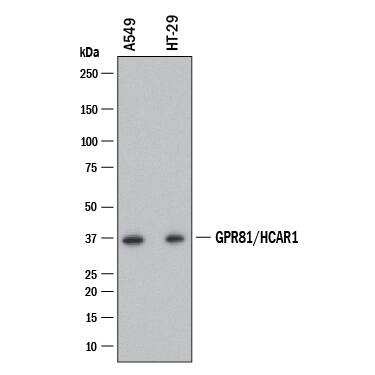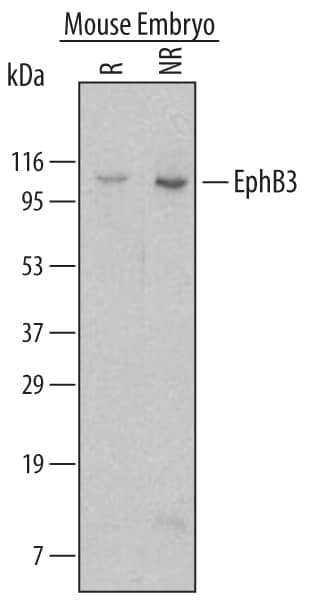Mouse EphB3 Antibody
R&D Systems, part of Bio-Techne | Catalog # MAB432

Key Product Details
Species Reactivity
Validated:
Mouse
Cited:
Mouse
Applications
Validated:
Western Blot
Cited:
Immunohistochemistry
Label
Unconjugated
Antibody Source
Monoclonal Rat IgG2A Clone # 521002
Product Specifications
Immunogen
Mouse myeloma cell line NS0-derived recombinant mouse EphB3
Leu30-Leu554
Accession # P54754
Leu30-Leu554
Accession # P54754
Specificity
Detects mouse EphB3 in direct ELISAs and Western blots. In direct ELISAs, 100% cross-reactivity with recombinant human (rh) EphB3 is observed and no cross-reactivity with recombinant rat EphB1, recombinant mouse (rm) EphB4, rmEphB2, rmEphB7, rmEphA4, rmEphA3, rhEphB2, or rhEphA5 is observed.
Clonality
Monoclonal
Host
Rat
Isotype
IgG2A
Scientific Data Images for Mouse EphB3 Antibody
Detection of Mouse EphB3 by Western Blot.
Western blot shows lysates of mouse brain tissue. PVDF membrane was probed with 2 µg/mL of Rat Anti-Mouse EphB3 Monoclonal Antibody (Catalog # MAB432) followed by HRP-conjugated Anti-Rat IgG Secondary Antibody (HAF005). A specific band was detected for EphB3 at approximately 130 kDa (as indicated). This experiment was conducted under reducing conditions and using Immunoblot Buffer Group 1.Detection of Mouse EphB3 by Western Blot.
Western blot shows lysates of A549 human lung carcinoma cell line and HT-29 human colon adenocarcinoma cell line. PVDF membrane was probed with 0.5 µg/mL of Rat Anti-Mouse EphB3 Monoclonal Antibody (Catalog # MAB432) followed by HRP-conjugated Anti-Mouse IgG Secondary Antibody (Catalog # HAF018). A specific band was detected for EphB3 at approximately 37 kDa (as indicated). This experiment was conducted under reducing conditions and using Western Blot Buffer Group 1.Applications for Mouse EphB3 Antibody
Application
Recommended Usage
Western Blot
2 and 0.5 µg/mL
Sample: Mouse brain tissue, A549 human lung carcinoma cell line and HT-29 human colon adenocarcinoma cell line
Sample: Mouse brain tissue, A549 human lung carcinoma cell line and HT-29 human colon adenocarcinoma cell line
Formulation, Preparation, and Storage
Purification
Protein A or G purified from hybridoma culture supernatant
Reconstitution
Reconstitute at 0.5 mg/mL in sterile PBS. For liquid material, refer to CoA for concentration.
Formulation
Lyophilized from a 0.2 μm filtered solution in PBS with Trehalose. *Small pack size (SP) is supplied either lyophilized or as a 0.2 µm filtered solution in PBS.
Shipping
Lyophilized product is shipped at ambient temperature. Liquid small pack size (-SP) is shipped with polar packs. Upon receipt, store immediately at the temperature recommended below.
Stability & Storage
Use a manual defrost freezer and avoid repeated freeze-thaw cycles.
- 12 months from date of receipt, -20 to -70 °C as supplied.
- 1 month, 2 to 8 °C under sterile conditions after reconstitution.
- 6 months, -20 to -70 °C under sterile conditions after reconstitution.
Background: EphB3
References
- Pasquale, E.B. (2008) Cell 133:38.
- Ruiz, J.C. et al. (1994) Mech. Dev. 48:153.
- Pasquale, E.B (2004) Nat. Neurosci. 7:417.
- Trivier, E. and T.S. Ganesan (2002) J. Biol. Chem. 277:23037.
- Miao, H. et al. (2005) J. Biol. Chem. 280:923.
- Adams, R.H. et al. (1999) Genes Dev. 13:295.
- Krull, C.E. et al. (1997) Curr. Biol. 7:571.
- Willson, C.A. et al. (2006) J. Mol. Histol. 37:369.
- Cortina, C. et al. (2007) Nature Genet. 39:1376.
- Birgbauer, E. et al. (2000) Development 127:1231.
- Alfaro, D. et al. (2008) Immunology 125:131.
- Risley, M. et al. (2009) Mech. Dev. 126:230.
- Liu, X. et al. (2006) J. Neurosci. 26:3087.
- Batlle, E. et al. (2005) Nature 435:1126.
- Holmberg, J. et al. (2006) Cell 125:1151.
Long Name
Eph Receptor B3
Alternate Names
Cek10, Hek2, Mdk5, Sek4, Tyro6
Gene Symbol
EPHB3
UniProt
Additional EphB3 Products
Product Documents for Mouse EphB3 Antibody
Product Specific Notices for Mouse EphB3 Antibody
For research use only
